Adyghe verbs
In Adyghe, like all Northwest Caucasian languages, the verb is the most inflected part of speech. Verbs are typically head final and are conjugated for tense, person, number, etc. Some of Circassian verbs can be morphologically simple, some of them consist only of one morpheme, like: кӏо "go", штэ "take". However, generally, Circassian verbs are characterized as structurally and semantically difficult entities. Morphological structure of a Circassian verb includes affixes (prefixes, suffixes) which are specific to the language. Verbs' affixes express meaning of subject, direct or indirect object, adverbial, singular or plural form, negative form, mood, direction, mutuality, compatibility and reflexivity, which, as a result, creates a complex verb, that consists of many morphemes and semantically expresses a sentence. For example: уакъыдэсэгъэгущы1эжьы "I am forcing you to talk to them again" consists of the following morphemes: у-а-къы-дэ-сэ-гъэ-гущы1э-жьы, with the following meanings: "you (у) with them (а) from there (къы) together (дэ) I (сэ) am forcing (гъэ) to speak (гущы1эн) again (жьы)".
Transitivity
In Adyghe the verb being transitive or intransitive is of major importance in accounting for the contrast between the two cases ergative and absolutive. The transitivity of the verb is the main factor determining the choice of the subject case. Polyvalent verbs can be both transitive (with an ERG prefix) and intransitive (without an ERG prefix), so intransitive verbs can have indirect objects.
The absolutive case in Adyghe serves to mark the noun that changes by the verb (i.e. created, altered, moved or ended.).
- In intransitive verbs the subject gets the absolutive case indicating that the subject is changing.
- In transitive verbs the subject gets the ergative case indicating that the subject causes change to the direct object which gets the absolutive case.
For example both the intransitive verb егъоин /jaʁʷəjən/ and the transitive verb дзын /d͡zən/ mean "to throw", but егъоин expresses the motion the thrower (subject) does to throw something while дзын expresses the movement of the object that was thrown (motion in air).
Кӏалэр лӏым егъои Кӏалэр лӏы-м егъои [t͡ʃʼaːɮar ɬʼəm jaʁʷajə] boy (abs.) man (obl.) (s)he is throwing "The boy is throwing at the man."
Кӏалэм мыжъор едзы Кӏалэ-м мыжъо-р едзы [t͡ʃʼaːɮam məʒʷa jad͡ʒə] boy (erg.) rock (abs.) (s)he throwing it "The boy is throwing the rock."
Steady-state verbs
Steady-state verbs express the condition, they express states or results of actions.
Examples :
- кӏалэр щыс /t͡ʃʼaːɮar ɕəs/ the boy is sitting.
- кӏалэр тет /t͡ʃʼaːɮar tajt/ the boy is standing on.
- кӏалэр илъ /t͡ʃʼaːɮar jəɬ/ the boy is laying inside.
- кӏалэр щыӏ /t͡ʃʼaːɮar ɕəʼ/ the boy exists.
| Subject pronouns |
Affixes | Examples | ||
|---|---|---|---|---|
| Cyrillic | IPA | |||
| Singular | 1st person | сы~ | /sə~/ | сыщыс /səɕəs/ – I am sitting. |
| 2st person | у~ | /wə~/ | ущыс /wəɕəs/ – you are sitting. | |
| 3rd person | - | - | щыс /ɕəs/ – (s)he is sitting. | |
| Plural | 1st person | ты~ | /tə~/ | тыщыс /təɕəs/ – we are sitting. |
| 2nd person | шъу~ | /ʃʷə~/ | шъущыс /ʃʷəɕəs/ – you are sitting. | |
| 3rd person | ~ых | /~əx/ | щысых /ɕəsəx/ – they are sitting. | |
Кӏалэр чъыгым ӏулъ Кӏалэ-р чъыгы-м ӏу-лъ [t͡ʃʼaːɮar t͡ʂəɣəm ʔʷəɬ] boy (abs.) tree (erg.) (s)he is laying near "The boy is laying near the tree."
Кӏалэр пхъэнтӏэкӏум тес Кӏалэ-р пхъэнтӏэкӏу-м те-с [t͡ʃʼaːɮar pχantʼakʷʼəm tajs] boy (abs.) chair (erg.) (s)he is sitting on "The boy is sitting on the chair."
Кӏалэр унэм ис Кӏалэ-р унэ-м и-с [t͡ʃʼaːɮar wənam jəs] boy (abs.) house (erg.) (s)he is sitting inside "The boy is sitting inside the house."
Verb valency
Verb valency is the number of arguments controlled by a verbal predicate. Verbs in Adyghe can be monovalent (e.g. I am sitting), bivalent (e.g. I am hitting an enemy), trivalent (e.g. I am giving a book to a friend), possibly also quadrivalent (e.g. I am telling the news to someone with my friend).
Monovalent verbs
Monovalent verbs can only be intransitive having one argument, an absolutive subject with no objects.
Examples :
- кӏалэр макӏо /t͡ʃʼaːɮar maːkʷʼa/ the boy is going.
- кӏалэр мачъэ /t͡ʃʼaːɮar maːt͡ʂa/ the boy is running.
- кӏалэр машхэ /t͡ʃʼaːɮar maːʃxa/ the boy is eating.
- кӏалэр маплъэ /t͡ʃʼaːɮar maːpɬa/ the boy is looking.
- кӏалэр мэгущыӏэ /t͡ʃʼaːɮar maɡʷəɕaːʔa/ the boy is speaking.
- кӏалэр малӏэ /t͡ʃʼaːɮar maːɬʼa/ the boy is dying.
| Subject pronouns |
Affixes | Examples | ||
|---|---|---|---|---|
| Cyrillic | IPA | |||
| Singular | 1st person | сэ~ | /sa~/ | сэкӏо /sakʷʼa/ - I am going |
| 2nd person | о~ | /wa~/ | окӏо /wakʷʼa/ - you are going | |
| 3rd person | ма~ | /maː~/ | макӏо /maːkʷʼa/ - (s)he is going | |
| Plural | 1st person | тэ~ | /ta~/ | тэкӏо /takʷʼa/ - we are going |
| 2nd person | шъо~ | /ʃʷa~/ | шъокӏо /ʃʷakʷʼa/ - you are going | |
| 3rd person | ма~ and ~эх | /maː~/ and /~ax/ | макӏох /maːkʷʼax/ - they are going | |
Томэр машхэ тиунэкӏэ Том-эр машхэ ти-унэ-кӏэ [tomar maːʃxa tiwnat͡ʃʼa] Tom (abs.) he is eating house (ins.) "Tom is eating in our house"
кӏалэр тиунэ къакӏо кӏалэ-эр ти-унэ къа-кӏо [t͡ʃʼaːɮar tiwna qaːkʷʼa] the boy (abs.) our house (s)he is coming "The boy is coming to our house"
пшъашъэр маплъэ тиунэ пакӏэ пшъашъэ-эр маплъэ ти-унэ пакӏэ [pʂaːʂar maːpɬa tiwna paːt͡ʃʼa] the girl (abs.) (s)he is looking our house direction "The girl is looking at our house's direction"
Bivalent verbs
Bivalent verbs in Adyghe can be either intransitive or transitive.
Intransitive bivalent verbs
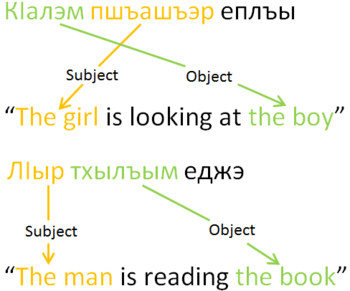
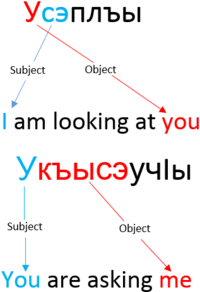
In a sentence with an intransitive bivalent verb :
- The subject is in the absolutive case.
- The indirect object is in the oblique case.
This indicates that the subject is changing by doing the verb.
Examples :
- кӏалэр егупшысэ /t͡ʃʼaːɮar jaɡʷəpʃəsa/ the boy is thinking of.
- кӏалэр ео /t͡ʃʼaːɮar jawa/ the boy is playing a.
- кӏалэр еджэ /t͡ʃʼaːɮar jad͡ʒa/ the boy is reading a.
- кӏалэр еплъы /t͡ʃʼaːɮar maːpɬa/ the boy is looking at.
- кӏалэр еупчӏы /t͡ʃʼaːɮar jawt͡ʂʼə/ the boy is asking a.
- кӏалэр елӏыкӏы /t͡ʃʼaːɮar jaɬʼət͡ʃʼə/ the boy is dying of.
- кӏалэр ебэу /t͡ʃʼaːɮar jabawə/ the boy is kissing a.
Кӏалэр пщынэ ео Кӏалэ-р пщынэ ео [t͡ʃʼaːɮar pɕəna jawa] boy (abs.) accordion (s)he playing a "The boy is playing an accordion"
лӏыр узым ылӏыкӏыгъ лӏы-р узы-м ылӏыкӏы-гъ [ɬʼər wəzəm əɬʼət͡ʃʼəʁ] the old man (abs.) disease (obl.) (s)he died of "the old man is drying from the disease"
The conjugation of the intransitive bivalent verb еплъын /japɬən/ "to look at":
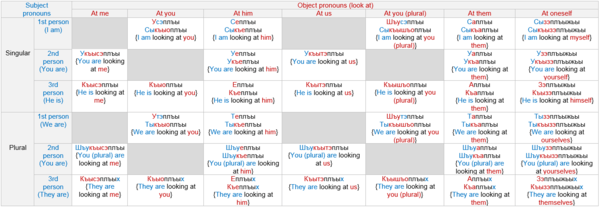
сэ о усэплъы сэ о у-сэ-плъы [sa wa wəsapɬə] I you I am looking at you "I am looking at you."
кӏалэр сэ къысао кӏалэ-р сэ къы-са-о [t͡ʃʼaːɮar sa qəsaːwa] the boy (abs.) I (s)he is hitting me "The boy is hitting me."
Transitive bivalent verbs
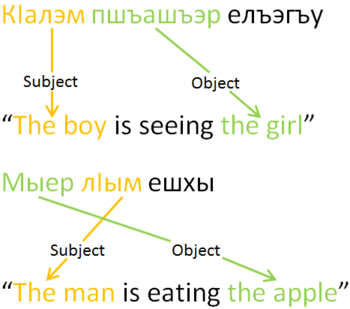

In a sentence with a transitive bivalent verbs:
- The subject is in ergative case.
- The direct object is in absolutive case.
This indicates that the subject causes change to the object.
Examples :
- кӏалэм елъэгъу /t͡ʃʼaːɮam jaɬaʁʷə/ the boy is seeing a.
- кӏалэм ешхы /t͡ʃʼaːɮam jaʃxə/ the boy is eating it.
- кӏалэм егъакӏо /t͡ʃʼaːɮam jaʁaːkʷʼa/ the boy is making someone go.
- кӏалэм екъутэ /t͡ʃʼaːɮam jaqʷəta/ the boy is destroying the.
- кӏалэм еукӏы /t͡ʃʼaːɮam jawt͡ʃʼə/ the boy is killing a.
- кӏалэм едзы /t͡ʃʼaːɮam jad͡zə/ the boy is throwing a.
Томэм ешхы мые Том-эм ешхы мые [tomam jaʃxə məja] Tom (erg.) (s)he is eating a apple "Tom is eating an apple"
Иусыфым кӏалэр тучаным егъакӏо Иусыф-ым кӏалэр тучан-ым егъакӏо [jəwsəfəm t͡ʃʼaːɮar tut͡ʃaːnəm jaʁaːkʷʼa] Joseph (erg.) the boy (abs.) shop (erg.) (s)he is making him go "Joseph is making the boy go to the shop"
In transitive verbs the left prefix pronoun is the object while the right prefix pronoun is the subject, for example in осэгъакӏо "I am making you go", the left prefix pronoun о "you" is the object while the right prefix pronoun сэ "I" is the subject.
The conjugation of the transitive bivalent verb ылъэгъун /əɬaʁʷən/ "to see it":
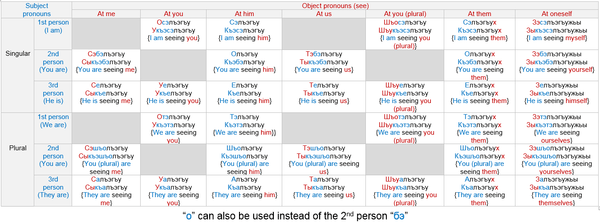
о сэ сыкъэбэлъэгъу о сэ сы-къэ-бэ-лъэгъу [wa sa səqabaɬaʁʷə] you I you are seeing me "You are seeing me."
кӏалэм сэ сеупчӏы упчӏэкӏэ кӏалэ-м сэ с-е-упчӏы упчӏэ-кӏэ [t͡ʃʼaːɮam sa sajwpt͡ʂʼə wəpt͡ʂʼat͡ʃʼa] boy (erg.) I I am asking him/her using a question (ins.) "I am asking the boy a question."
Trivalent verbs
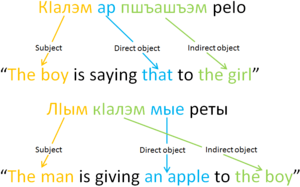
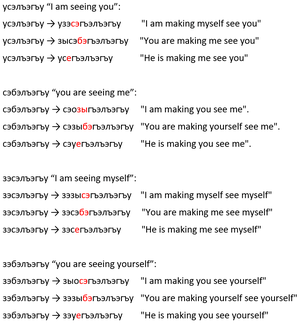
Trivalent verbs require three arguments : a subject, a direct object and an indirect object:
- The subject is in ergative case.
- The direct object is in absolutive case.
- The indirect object is in oblique case.
Most trivalent verbs in Adyghe are created by adding the causative prefix to bivalent verbs. The causative prefix increases the valency of the verb by one and forms a transitive, thus bivalent verbs become trivalent. Intransitive bivalent verbs that become trivalent have different conjunction than transitive bivalent verbs that become trivalent, thus we end up with two types of trivalent verbs.
To form a trivalent verb one must take a bivalent verb (either intransitive or transitive), add the causative prefix -гъэ /-ʁa/ and the subject's pronoun prefix to the right.
Examples of intransitive verbs:
- ео /jawa/ "(s)he is hitting him/it" → ебэгъао /jabaʁaːwa/ "You are making him hit him/it".
- уеджэ /wajd͡ʒa/ "you are reading it" → уесэгъаджэ /wajsaʁaːd͡ʒa/ "I am making you read it".
- усэплъы /wsapɬə/ "I am looking at you" → усэзэгъэплъы /wsazaʁapɬə/ "I am making myself look at you".
- укъысэупчӏы /wqəsawt͡ʂʼə/ "you are asking me" → укъысегъэупчӏы /wqəsajʁawt͡ʂʼə/ "(s)he is making you ask me".
Examples of transitive verbs:
- едзы /jad͡zə/ "(s)he is throwing him/it" → ебэгъэдзы /jabaʁad͡zə/ "You are making him throw him/it".
- ошхы /waʃxə/ "you are eating it" → осэгъэшхы /wasaʁaʃxə/ "I am making you eat it".
- осэлъэгъу /wasaɬaʁʷə/ "I am seeing you" → осэзэгъэлъэгъу /wasazaʁaɬaʁʷə/ "I am making myself see you".
- сэбэукӏы /sabawt͡ʃʼə/ "you are killing me" → сэуегъэукӏы /sawajʁawt͡ʃʼə/ "(s)he is making you kill me".
Intransitive verbs to trivalent
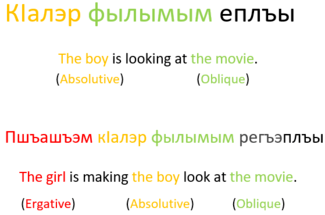
These verbs are formed by adding the causative prefix to intransitive bivalent verbs, increacing their valency and making them transitive.
Examples :
- кӏалэм регъаджэ /t͡ʃʼaːɮam rajʁaːd͡ʒa/ the boy is making him read it.
- кӏалэм регъэплъы /t͡ʃʼaːɮam rajʁapɬə/ the boy is making him watch it.
- кӏалэм регъэджыджэхы /t͡ʃʼaːɮam rajʁad͡ʒəd͡ʒaxə/ the boy is making him roll down it.
унэм уесэгъэплъы унэ-м у-е-сэ-гъэ-плъы [wənam wajsaʁapɬə] house (erg.) I am making you look at it "I am making you look at the house." "I (subject) am making you (direct object) look at the house (indirect object)."
кӏалэм пшъэшъэр фылымым регъэплъы кӏалэ-м пшъэшъэ-р фылым-ым ре-гъэ-плъы [t͡ʃʼaːɮam pʂaːʂar fələməm rajʁapɬə] boy (erg.) girl (abs.) film (obl.) (s)he is making him watch it "The boy is making the girl watch the film." "The boy (subject) is making the girl (direct object) watch the film (indirect object)."
кӏэлэегъаджэм кӏалэр арегъаджэ тхылъыхэмэ кӏэлэегъадж-эм кӏалэ-р а-ре-гъа-джэ тхылъы-хэ-мэ [t͡ʃʼaɮajaʁaːd͡ʒar t͡ʃʼaːɮar aːrajʁaːd͡ʒa txəɬəxama] teacher (erg.) boy (abs.) (s)he is making him read them books (obl.) "The teacher is making the boy read the books." "The teacher (subject) is making the boy (direct object) read the books (indirect object)."
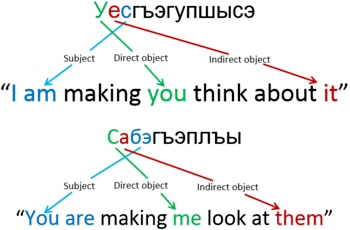
The conjugation of the trivalent verb with an intransitive origin:
- The first prefix indicates the direct object (absolutive).
- The second prefix indicates the indirect object (oblique).
- The third prefix indicates the subject (ergative).
 indirect object (me)
indirect object (me) indirect object (you)
indirect object (you) indirect object (him)
indirect object (him) indirect object (us)
indirect object (us) indirect object (you plural)
indirect object (you plural) indirect object (them)
indirect object (them)
Transitive verbs to trivalent
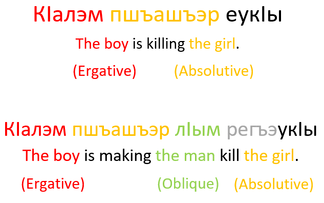
These verbs can be formed by adding the causative prefix to transitive bivalent verbs. There are some exceptional transitive verbs that are trivalent by default without any increacing valecy prefixes such as етын "to give".
Examples :
- кӏалэм реӏо /t͡ʃʼaːɮam rajʔʷa/ the boy is saying it to him.
- кӏалэм реты /t͡ʃʼaːɮam rajʔʷa/ the boy is giving it to him.
- кӏалэм редзы /t͡ʃʼaːɮam rajd͡zə/ the boy is signing it on something.
- кӏалэм къыӏепхъуатэ /t͡ʃʼaːɮam qəʔajpχʷaːta/ the boy snatches it from him.
- уесэубытэ /wajsawbəta/ "I am holding you forcefully in it".
- уесэӏуатэ /wajsaʔʷaːta/ "I snitching you to him".
- уесэты /wajsatə/ "I am giving you to him".
- уесэгъэлъэгъу /wesaʁaɬaʁʷə/ "I am making him see you".
унэр къыосэгъэлъэгъу унэ-р къыо-сэ-гъэ-лъэгъу [wənar qəwasaʁaɬaʁʷə] house (abs.) I am showing it to you "I am showing the house to you.." "I am (subject) making you (direct object) see the house (indirect object)."
кӏалэм фылымыр пшъэшъэм регъэлъэгъу кӏалэ-м фылым-ыр пшъэшъэ-м ре-гъэ-плъы [t͡ʃʼaːɮam pʂaːʂar fələməm rajʁaɬaʁʷə] boy (erg.) film (abs.) girl (obl.) (s)he is showing it to him "The boy is showing the film to the girl." "The boy (subject) is making the girl (direct object) see the film (indirect object)."
кӏалэм шхыныр пшъашъэм реты кӏалэ-м шхыны-р пшъашъэ-м реты [t͡ʃʼaːɮam ʃxənər pʂaːʂam rajtə] boy (erg.) food (abs.) girl (obl.) (s)he is giving it to him/her "The boy is giving the food to the girl." "The boy (subject) is giving the girl (direct object) the food (indirect object)."

The conjugation of the trivalent verb with a transitive origin:
- The first prefix indicates the indirect object (oblique).
- The second prefix indicates the direct object (absolutive).
- The third prefix indicates the subject (ergative).
 direct object (me)
direct object (me) direct object (you)
direct object (you) direct object (him)
direct object (him) direct object (us)
direct object (us) direct object (you plural)
direct object (you plural) direct object (them)
direct object (them)
Infinitives
Adyghe infinitives are created by suffixing -н to verbs. For example:
- кӏо /kʷʼa/ "go" → кӏон /kʷʼan/ "to go"
- ӏо /ʔʷa/ "say" → ӏон /ʔʷan/ "to say"
Along with roots, verbs already inflected can be conjugated, such as with person:
- ошхэ /waʃxa/ "you are eating" → ушхэн /wəʃxan/ "(for) you (to) eat"
Also, due to the interchangeability of nouns and verbs, infinitives can be constructed from nouns, resulting in verbs that describe the state of being the suffixed word.
- мафэ /maːfa/ - day → мэфэн /mafan/ - to be a day.
- кӏалэ /t͡ʃʼaːɮa/ - boy → кӏэлэн /t͡ʃʼaɮan/ - to be a boy.
- дахэ /daːxa/ - pretty → дэхэн /daxan/ - (for) he/she/it (to) be pretty.
- кӏэхьы /t͡ʃʼaħə/ - long → кӏэхьын /t͡ʃʼaħən/ - (for) he/she/it (to) be long.
пшъашъэр дэхэн фай [pʂaːʂar daxan faːj] the girl (abs.) to be pretty must/have to "the girl must be pretty" "the girl has to be pretty" тиунэ укъихьэн фэшӏыкӏэ укӏэлэн фай [tiwna wqiħan faʃʼət͡ʃʼa wt͡ʃʼalan faːj] our house (to) you come in for him (ins.) you (to) be boy must/have to "to come inside our house, you have to be a boy" "to come inside our house, you must be a boy"
Future Tense Suffix -ну (-nəw):
сэ къыосӏонэу сыфай [sa qəwasʔʷanəw səfaːj] i I (to) tell you I want "I want to tell you" цIыфым шъушхэнэу къышъуиӏуагъ [t͡sʼafəm ʃʷəʃxanəw qəʃʷiʔʷaːʁ] the person (erg.) you (plural) (to) eat (adv.) he told you (plural) "the person told you, to eat (plural)"
Verbal affixes
Imperative mood
The imperative mood of the second person singular has no additional affixes:
- штэ /ʃta/ "take"
- кӏо /kʷʼa/ "go"
- тхы /txə/ "write"
- шхэ /ʃxa/ "eat"
When addressing to several people, The prefix шъу- /ʃʷə-/ is added:
- шъушт /ʃʷəʃt/ "take (said to plural)"
- шъукӏу /ʃʷəkʷʼ/ "go (said to plural)"
- шъутх /ʃʷətx/ "write (said to plural)"
- шъушх /ʃʷəʃx/ "eat (said to plural)"
Tense
Simple past
The verbs in simple past tense are formed by adding -aгъ /-aːʁ/. In intransitive verbs it indicate that the action took place, but with no indication as to the duration, instant nor completeness of the action. In transitive verbs it convey more specific information as regards to completeness of the action, and therefore they indicate some certainty as to the outcome of the action.
Examples :
- кӏо /kʷʼa/ go → кӏуагъ /kʷʼaːʁ/ (s)he went
- къакӏу /qaːkʷʼ/ come → къэкӏуагъ /qakʷʼaːʁ/ (s)he came
- шхэ /ʃxa/ eat! → шхагъ /ʃxaːʁ/ (s)he ate
- ӏо /ʔʷa/ say → ыӏуагъ /jəʔʷaːʁ/ (s)he said
- еплъ /japɬ/ look at → еплъыгъ /japɬəʁ/ (s)he looked at
- шхы /ʃxə/ eat it → ышхыгъ /jəʃxəʁ/ (s)he ate it
| Plurality | Person | Cyrillic | IPA | Meaning |
|---|---|---|---|---|
| Singular | First-person | скӏуагъ, седжагъ | skʷʼaːʁ, sajd͡ʒaːʁ | I went, I [have] read |
| Second-person | укӏуагъ, уеджагъ | wkʷʼaːʁ, wajd͡ʒaːʁ | You went, You [have] read | |
| Third-person | кӏуагъ, еджагъ | kʷʼaːʁ, jad͡ʒaːʁ | He went, He [has] read | |
| Plural | First-person | ткӏуагъ, теджагъ | tkʷʼaːʁ, tajd͡ʒaːʁ | We went, We [have] read |
| Second-person | шъукӏуагъ, шъуеджагъ | ʃʷkʷʼaːʁ, ʃʷajd͡ʒaːʁ | You (pl.) went, You [have] read | |
| Third-person | кӏуагъэх, еджагъэх | kʷʼaːʁax, jad͡ʒaːʁax | They went, They [have] read | |
Сэ шхынхэр къэсхьыгъэх Сэ шхын-хэ-р къэ-с-хьы-гъэ-х [sa ʃxənxar qasħəʁax] I foods (abs.) I brought them "I brought the foods (and they might still be here)."
Кӏалэр тиунэ къэкӏуагъ Кӏалэ-р ти-унэ къэ-кӏу-агъ [t͡ʃʼaːɮar təjwəna qakʷʼaːʁ] the boy (abs.) our house (s)he came "The boy came to our house (and he might still be here)."
Discontinuous past
The verbs in discontinuous past tense are formed with the additional suffix -гъагъ /-ʁaːʁ/. It indicates that the action took place formerly at some certain time, putting emphasis only on the fact that the action took place (not the duration). It also carries an implication that the result of the event described no longer holds. This tense expresses the following meanings: remote past, anti resultative (‘cancelled’ result), experiential and irrealis conditional.[1]
Examples :
- кӏо /kʷʼa/ go → кӏогъагъ /kʷʼaʁaːʁ/ (s)he went once upon a time, or formerly
- къакӏу /qaːkʷʼ/ come → къэкӏогъагъ /qakʷʼaʁaːʁ/ (s)he came (then)
- шхэ /ʃxa/ eat! → шхэгъагъ /maʃxaʁaːʁ/ (s)he ate (then)
- ӏо /ʔʷa/ say → ыӏогъагъ /jəʔʷaʁaːʁ/ (s)he said (then)
- еплъ /japɬ/ look at → еплъыгъагъ /japɬəʁaːʁ/ (s)he looked at (then)
- шхы /ʃxə/ eat it → ышхыгъагъ /jəʃxəʁaːʁ/ (s)he ate it (then)
| Plurality | Person | Cyrillic | IPA | Meaning |
|---|---|---|---|---|
| Singular | First-person | скӏогъагъ, седжэгъагъ | skʷʼaʁaːʁ, sajd͡ʒaʁaːʁ | I went (then), I read (then) |
| Second-person | укӏогъагъ, уеджэгъагъ | wkʷʼaʁaːʁ, wajd͡ʒaʁaːʁ | You went (then), You read (then) | |
| Third-person | кӏогъагъ, еджэгъагъ | kʷʼaʁaːʁ, jad͡ʒaʁaːʁ | He went (then), He read (then) | |
| Plural | First-person | ткӏогъагъ, теджэгъагъ | tkʷʼaʁaːʁ, tajd͡ʒaʁaːʁ | We went (then), We read (then) |
| Second-person | шъукӏогъагъ, шъуеджэгъагъ | ʃʷkʷʼaʁaːʁ, ʃʷajd͡ʒaʁaːʁ | You (pl.) went (then), You (pl.) read (then) | |
| Third-person | кӏогъагъэх, еджэгъагъэх | kʷʼaʁaːʁax, jad͡ʒaʁaːʁax | They went (then), They read (then) | |
Сэ шхынхэр къэсхьыгъагъэх Сэ шхын-хэ-р къэ-с-хьы-гъагъэ-х [sa ʃxənxar qasħəʁaːʁax] I foods (abs.) I brought them (then) "I brought the foods (back then)."
Кӏалэр тиунэ къэкӏогъагъ Кӏалэ-р ти-унэ къэ-кӏу-эгъагъ [t͡ʃʼaːɮar təjwəna qakʷʼaʁaːʁ] the boy (abs.) our house (s)he came (then) "The boy came to our house (and he might have left)."
Present tense
Examples :
- кӏо /kʷʼa/ go → макӏо /makʷʼa/ (s)he goes
- къакӏу /qaːkʷʼ/ come → къакӏо /qakʷʼa/ (s)he comes
- шхэ /ʃxa/ eat! → машхэ /maʃxaʁ/ (s)he eats
- ӏо /ʔʷa/ say → еӏо /jəʔʷa/ (s)he says
- еплъ /japɬ/ look at → еплъы /japɬə/ (s)he looks at
- шхы /ʃxə/ eat it → ешхы /jəʃxə/ (s)he eats it
| Plurality | Person | Cyrillic | IPA | Meaning |
|---|---|---|---|---|
| Singular | First-person | сэкӏо, седжэ | sakʷʼa, sajd͡ʒa | I go, I read |
| Second-person | окӏо, уеджэ | wakʷʼa, wajd͡ʒa | You go, You read | |
| Third-person | макӏо, еджэ | maːkʷʼa, jad͡ʒa | He goes, He read | |
| Plural | First-person | тэкӏо, теджэ | takʷʼa, tajd͡ʒa | We go, We read |
| Second-person | шъокӏо, шъуеджэ | ʃʷakʷʼa, ʃʷajd͡ʒa | You (pl.) go, You read | |
| Third-person | макӏох, еджэх | maːkʷʼax, jad͡ʒax | They goes, They read | |
Сиунэ сшэшхэ [siwna sʃaʃxa] my house I eat in "I eat in my house" мые сэшэфы [məja saʃafə] an apple I am buying "I am buying an apple"
Future tense
The future tense is normally indicated by the suffix ~(э)щт /~(a)ɕt/ (close to future simple), reduced to ~т in some dialects, such as Hatukai, Bzhedug and Great Shapsug. This suffix usually expresses some certainty.
Examples :
- макӏо /maːkʷʼa/ (s)he is going → кӏощт /kʷʼaɕt/ (s)he will go
- къакӏо /qaːkʷʼa/ (s)he is coming → къэкӏощт /qakʷʼaɕt/ (s)he will come
- машхэ /maːʃxa/ (s)he is eating → шхэщт /ʃxaɕt/ (s)he will eat
- еӏо /jaʔʷa/ (s)he says → ыӏощт /jəʔʷaɕt/ (s)he will say
- еплъы /jajapɬə/ (s)he looks at → еплъыщт /japɬəɕt/ (s)he will look at
- ешхы /jaʃxə/ (s)he eats it → ышхыщт /jəʃxəaɕt/ (s)he will eat it
| Plurality | Person | Cyrillic | IPA | Meaning |
|---|---|---|---|---|
| Singular | First-person | скӏощт, седжэщт | skʷʼaɕt, sajd͡ʒaɕt | I will go, I will read |
| Second-person | укӏощт, уеджэщт | wkʷʼaɕt, wajd͡ʒaɕt | You will go, You will read | |
| Third-person | кӏощт, еджэщт | kʷʼaɕt, jad͡ʒaɕt | He will go, He will read | |
| Plural | First-person | ткӏощт, теджэщт | tkʷʼaɕt, tajd͡ʒaɕt | We will go, We will read |
| Second-person | шъукӏощт, шъуеджэщт | ʃʷkʷʼaɕt, ʃʷajd͡ʒaɕt | You (pl.) will go, You will read | |
| Third-person | кӏощтых, еджэщтых | kʷʼaɕtəx, jad͡ʒaɕtəx | They will go, They will read |
Сиунэ сшышхэщт [siwna sʃəʃxaɕt] my house I will eat in "I will eat in my house" мые сшэфыщт [məja sʃafəɕt] an apple I will buy "I will buy an apple"
Future in the past
Future in the past tense is indicated by the suffix ~(э)щтэгъ /(a)ɕtaʁ/, reduced to ~тэгъ in some dialects, such as Bzhedug, Shapsug.
Examples :
- кӏо /kʷʼa/ go → кӏощтэгъ /makʷʼaɕtaʁ/ (s)he was going to go.
- къакӏу /qaːkʷʼ/ come → къэкӏощтэгъ /qakʷʼaɕtaʁ/ (s)he was going to come
- шхэ /ʃxa/ eat! → шхэщтэгъ /maʃxaɕtaʁ/ (s)he was going to eat
- ӏо /ʔʷa/ say → ыӏощтэгъ /jəʔʷaɕtaʁ/ (s)he was going to say
- еплъ /japɬ/ look at → еплъыщтэгъ /japɬəɕtaʁ/ (s)he was going to look at
- шхы /ʃxə/ eat it → ышхыщтэгъ /jəʃxəɕtaʁ/ (s)he was going to eat it
| Plurality | Person | Cyrillic | IPA | Meaning |
|---|---|---|---|---|
| Singular | First-person | скӏощтэгъ, седжэщтэгъ | skʷʼaɕtaʁ, sajd͡ʒaɕtaʁ | I was going to go, I was going to read |
| Second-person | укӏощтэгъ, уеджэщтэгъ | wkʷʼaɕtaʁ, wajd͡ʒaɕtaʁ | You were going to go, You were going to read | |
| Third-person | кӏощтэгъ, еджэщтэгъ | kʷʼaɕtaʁ, jad͡ʒaɕtaʁ | (S)he was going to go, He was going to read | |
| Plural | First-person | ткӏощтэгъ, теджэщтэгъ | tkʷʼaɕtaʁ, tajd͡ʒaɕtaʁ | We were going to go, We were going to read |
| Second-person | шъукӏощтэгъ, шъуеджэщтэгъ | ʃʷkʷʼaɕtaʁ, ʃʷajd͡ʒaɕtaʁ | You (pl.) were going to go, You were going to read | |
| Third-person | кӏощтыгъэх, еджэщтэгъэх | kʷʼaɕtəʁax, jad͡ʒaɕtaʁax | They were going to go, They were going to read | |
сыкӏощтэгъ еджапӏэм укъэмыкӏуагъэу сы-кӏо-щтыгъ еджапӏэ-м у-къэ-мы-кӏу-агъ-эу [səkʷʼaɕtəʁ jad͡ʒaːpʼam wqaməkʷʼaːʁae] I was going to the school (erg.) before you came "I was going to go to school before you came."
сеощтыгъэп ау сигъэгуабжи сеожьыгъ аужьырым с-ео-щтыгъ-эп ау с-и-гъэ-гуабж-и с-ео-жьы-гъ аужьырым [sajwaɕtəʁap aːw sajʁaɡʷaːbʒəj sajwaʑʁa aːwʑərəm] I wasn't going to hit him but because (s)he is making me angry I hit him at the end "I wasn't going to hit him, but then he made me angry and I actually hit him in the end."
Conditional perfect
Conditional perfect can also be indicated by the suffix ~щтэгъ /ɕtaʁ/.
Examples :
- кӏо /kʷʼa/ go → кӏощтэгъ /makʷʼaɕtaʁ/ (s)he would have gone.
- къакӏу /qaːkʷʼ/ come → къэкӏощтэгъ /qakʷʼaɕtaʁ/ (s)he would have come
- шхэ /ʃxa/ eat! → шхэщтэгъ /maʃxaɕtaʁ/ (s)he would have eaten.
- ӏо /ʔʷa/ say → ыӏощтэгъ /jəʔʷaɕtaʁ/ (s)he would have said.
- еплъ /japɬ/ look at → еплъыщтэгъ /japɬəɕtaʁ/ (s)he would have looked at
- шхы /ʃxə/ eat it → ышхыщтэгъ /jəʃxəɕtaʁ/ (s)he would have eaten it.
| Plurality | Person | Cyrillic | IPA | Meaning |
|---|---|---|---|---|
| Singular | First-person | скӏощтэгъ, седжэщтэгъ | skʷʼaɕtaʁ, sajd͡ʒaɕtaʁ | I would have gone, I would have read |
| Second-person | укӏощтэгъ, уеджэщтэгъ | wkʷʼaɕtaʁ, wajd͡ʒaɕtaʁ | You would have gone, You would have read | |
| Third-person | кӏощтэгъ, еджэщтэгъ | kʷʼaɕtaʁ, jad͡ʒaɕtaʁ | (S)he would have gone, (S)he would have read | |
| Plural | First-person | ткӏощтэгъ, теджэщтэгъ | tkʷʼaɕtaʁ, tajd͡ʒaɕtaʁ | We would have gone, We would have read |
| Second-person | шъукӏощтэгъ, шъуеджэщтэгъ | ʃʷkʷʼaɕtaʁ, ʃʷajd͡ʒaɕtaʁ | You (pl.) would have gone, You would have read | |
| Third-person | кӏощтыгъэх, еджэщтэгъэх | kʷʼaɕtəʁax, jad͡ʒaɕtaʁax | They would have gone, They would have read | |
экзамен зэрэтиӏэ сышӏэгъагъэмэ сфеджэщтэгъ экзамен зэрэ-ти-ӏэ сы-шӏэ-гъагъэ-мэ с-ф-еджэ-щтэгъ [akzaːmen zaratəjʔa səʃʼaʁaːʁna sfajd͡ʒaɕtaʁ] exam that we have if I knew I would have studied for it "If I knew we had an exam I would have studied for it."
а пшъашъэр къэсгъотышъущтэгъ тичылэдэсгъагъэмэ а пшъашъэ-р къэ-с-гъоты-шъу-щтэгъ ти-чылэдэс-гъагъэ-мэ [aː pʂaːʂar qasʁʷatəʃʷɕtaʁ təjt͡ʃəɮadasʁaːʁami] that girl (abs.) I could have found it if (s)he was our villager "I could have found that girl if she was our villager."
Future perfect
The future perfect tense is indicated by adding the suffix ~гъэщт or ~гъагъэщт. This tense indicates action that will be finished or expected to be finished at a certain time in the future.
Examples :
- кӏо /kʷʼa/ go → кӏогъэщт /makʷʼaʁaɕt/ (s)he will have gone.
- къакӏу /qaːkʷʼ/ come → къэкӏогъэщт /qakʷʼaʁaɕt/ (s)he will have come.
- шӏы /ʃʼə/ do it → ыш1ыгъагъэщт /ət͡ʃʼəʁaːʁaɕt/ (s)he will have done it.
- ӏо /ʔʷa/ say → ыӏогъэщт /jəʔʷaʁaɕt/ (s)he will have said it.
- еплъ /japɬ/ look at → еплъыгъэщт /japɬəʁaɕt/ (s)he will have looked at.
- шхы /ʃxə/ eat it → ышхыгъэщт /jəʃxəʁaɕt/ (s)he will have eaten it.
| Plurality | Person | Cyrillic | IPA | Meaning |
|---|---|---|---|---|
| Singular | First-person | скӏогъэщт, седжэгъэщт | skʷʼaʁaɕt, sajd͡ʒaʁaɕt | I will have gone, I will have read |
| Second-person | укӏогъэщт, уеджэгъэщт | wkʷʼaʁaɕt, wajd͡ʒaʁaɕt | You will have gone, You will have read | |
| Third-person | кӏогъэщт, еджэгъэщт | kʷʼaʁaɕt, jad͡ʒaʁaɕt | (S)he will have gone, (S)he will have read | |
| Plural | First-person | ткӏогъэщт, теджэгъэщт | tkʷʼaʁaɕt, tajd͡ʒaʁaɕt | We will have gone, We will have read |
| Second-person | шъукӏогъэщт, шъуеджэгъэщт | ʃʷkʷʼaʁaɕt, ʃʷajd͡ʒaʁaɕt | You (pl.) will have gone, You will have read | |
| Third-person | кӏощтыгъэх, еджэгъэщтэх | kʷʼaɕtəʁax, jad͡ʒaʁaɕtax | They will have gone, They will have read | |
сэ тхылъым седжэгъэщт неущы сэ тхылъы-м с-еджэ-гъэщт неущы [sa txəɬəm sajd͡ʒaʁaɕt najɕə] I book (erg.) I will have read it tomorrow "I will have read the book by tomorrow".
чэщым к1алэр сиунэ къэк1уагъэщт чэщы-м к1алэ-р си-унэ къэк1у-агъэщт [t͡ʃaɕəm t͡ʃʼaːɮar səjwəna qakʷaːʁaɕt] night (erg.) booy (abs.) my house (s)he will have came "the boy will have came to my house by night".
Positional conjugation
In Adyghe, the positional prefixes are expressing being in different positions and places and can also express the direction of the verb. Here is the positional conjugation of some dynamic verbs, showing how the prefix changes the indicated direction of the verb:
| Position | Prefix | Example | |
|---|---|---|---|
| Looking | Throwing | ||
| Body position/Pose | щы~ [ɕə~] | щеплъэ [ɕajpɬa] "(s)he is looking at that place" | щедзы [ɕajd͡za] "(s)he is throwing at that place" |
| On | те~ [taj~] | теплъэ [ɕajpɬa] "(s)he is looking on" | тедзэ [ɕajd͡za] "(s)he is throwing at" |
| Under | чӏэ~ [ʈ͡ʂʼa~] | чӏаплъэ [ʈ͡ʂʼaːpɬa] "(s)he is looking under" | чӏедзэ [ʈ͡ʂʼajd͡za] "(s)he is throwing under" |
| Through | хэ~ [xa~] | хаплъэ [xaːpɬa] "(s)he is looking through" | хедзэ [xajd͡za] "(s)he is throwing through" |
| Within some area | дэ~ [da~] | даплъэ [daːpɬa] "(s)he is looking at some area" | дедзэ [dajd͡za] "(s)he is throwing at some area" |
| Inside an object | даплъэ [daːpɬa] "(s)he is looking inside an object" | дедзэ [dajd͡za] "(s)he is throwing inside an object" | |
| Around | ӏу~ [ʔʷə~] | ӏуаплъэ [ʔʷaːpɬa] "(s)he is looking around" | ӏуедзэ [ʔʷajd͡za] "(s)he is throwing around" |
| Inside | и~ [jə~] | еплъэ [japɬa] "(s)he is looking inside" | редзэ [rajd͡za] "(s)he is throwing inside" |
| Hanged/Attached | пы~ [pə~] | пэплъэ [papɬa] "(s)he is searching by looking" | педзэ [pajd͡za] "(s)he is hanging by throwing" |
| Behind | къо~ [qʷa~] | къуаплъэ [qʷaːpɬa] "(s)he is looking behind" | къуедзэ [qʷajd͡za] "(s)he is throwing behind" |
| Aside | го~ [ɡʷa~] | гуаплъэ [ɡʷaːpɬa] "(s)he is looking aside" | гуедзэ [ɡʷajd͡za] "(s)he is throwing aside" |
| Against | пэӏу~ [paʔʷə~] | пэӏуаплъэ [paʔʷaːpɬa] "(s)he is looking against" | пэӏуедзэ [paʔʷajd͡za] "(s)he is throwing against" |
| Backwards | зэкӏ~ [zat͡ʃʼ~] | зэкӏаплъэ [zat͡ʃʼaːpɬa] "(s)he is looking backwards" | зэкӏедзэ [zat͡ʃʼajd͡za] "(s)he is throwing backwards" |
| Inside within | кӏоцӏы~ [kʷʼat͡sʼə~] | кӏоцӏаплъэ [kʷʼat͡sʼaːpɬa] "(s)he is looking within inside" | кӏоцӏедзэ [kʷʼat͡sʼajd͡za] "(s)he is throwing within inside" |
| Toward | лъы~ [ɬə~] | лъэплъэ [ɬapɬa] "(s)he is looking toward" | лъедзы [ɬajd͡zə] "(s)he is throwing toward" |
| Pass | блэ~ [bɮa~] | блэплъы [bɮapɬə] "(s)he is looking pass" | бледзэ [bɮajd͡za] "(s)he is throwing pass" |
| Over | шъхьэдэ~ [ʂħada~] | шъхьэдэплъы [ʂħadapɬə] "(s)he is looking pass over" | шъхьэдедзы [ʂħadajd͡zə] "(s)he is throwing pass over" |
| Beyond | шъхьэпы~ [ʂħada~] | шъхьэпэплъы [ʂħapapɬə] "(s)he is looking beyond" | шъхьэпедзы [ʂħapajd͡zə] "(s)he is throwing beyond" |
| Directly | жэхэ~ [ʒaxa~] | жэхаплъэ [ʒaxaːpɬa] "(s)he is glaring at one's face" | жэхедзэ [ʒaxajd͡za] "(s)he is throwing at one's face" |
| Mouth | жэдэ~ [ʒada~] | жэдаплъэ [ʒadaːpɬa] "(s)he is looking at a mouth" | жэдедзэ [ʒadajd͡za] "(s)he is throwing at a mouth" |
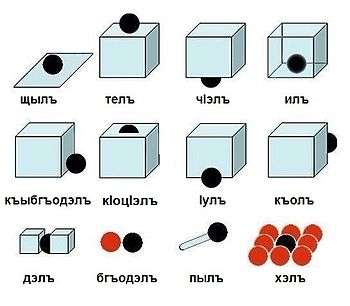
кӏалэм шхынхэр ӏанэм телъхьэх кӏалэ-м шхын-хэ-р ӏанэ-м те-лъхьэ-х [t͡ʃʼaːɮam ʃxənxar ʔaːnam tajɬħax] boy (erg.) foods (abs.) table (erg.) (s)he puts them on "The boy is putting the foods on the table."
мы гущыӏэм къэлэмкӏэ гуатх мы гущыӏ-эм къэлэм-кӏэ гуа-тх [mə ɡʷəɕəʔam qalamt͡ʃʼa ɡʷaːtx] this word (erg.) using a pencil (ins.) write aside "Write aside this word with a pencil."
Here is the positional conjugation of some steady-state verbs, showing how the root changes the indicated position:
| prefix | stands | sits | lies | |
| Body position/Pose | щы~ (ɕə~) | щыт (ɕət) | щыс (ɕəs) | щылъ (ɕəɬ) |
| On | те~ (taj~) | тет (tat) | тес (tas) | телъ (taɬ) |
| Under | чӏэ~ (ʈ͡ʂʼa~) | чӏэт (ʈ͡ʂʼat) | чӏэс (ʈ͡ʂʼas) | чӏэлъ (ʈ͡ʂʼaɬ) |
| Among | хэ~ (xa~) | хэт (xat) | хэс (xas) | хэлъ (xaɬ) |
| Within some mass | ||||
| Within some area | дэ~ (da~) | дэт (dat) | дэс (das) | дэлъ (daɬ) |
| Inside an object | ||||
| Around | ӏу~ (ʔʷə~) | ӏут (ʔʷət) | ӏyc (ʔʷəs) | ӏулъ (ʔʷəɬ) |
| Inside | и~ (jə~) | ит (jət) | иc (jəs) | илъ (jəɬ) |
| Hanged | пы~ (pə~) | пыт (pət) | пыc (pəs) | пылъ (pəɬ) |
| Attached | ||||
| Behind | къо~ (qʷa~) | къот (qʷat) | къоc (qʷas) | къолъ (qʷaɬ) |
| Aside | го~ (ɡʷa~) | гот (ɡʷat) | гоc (ɡʷas) | голъ (ɡʷaɬ) |
| Inside within | кӏоцӏы~ (kʷʼat͡sʼə~) | кӏоцӏыт (kʷʼat͡sʼət) | кӏоцӏыc (kʷʼat͡sʼəs) | кӏоцӏылъ (kʷʼat͡sʼəɬ) |
шхыныр ӏанэм телъ шхын-ыр ӏанэ-м те-лъ [ʃxənər ʔaːnam tajɬ] food (abs.) table (erg.) laying on "The food is on the table."
кӏалэхэр тучаным ӏутых кӏалэ-хэ-р тучан-ым ӏут-ых [t͡ʃʼaːɮaxar tut͡ʃaːnəm ʔʷətəx] boys (abs.) shop (erg.) standing around "The boys are standing near the shop."
Direction
In Adyghe verbs indicate the direction they are directed at. They can indicate the direction from different points of view by adding the fitting prefixes or changing the right vowels.
Towards and off
In Adyghe, the positional conjugation prefixes in the transitive verbs are indicating the direction of the verb. According to the verb's vowels, it can be described if the verb is done toward the indicated direction or off it. Usually high vowels (е /aj/ or э /a/) designates that the verb is done towards the indicated direction while low vowels (ы /ə/) designates that the verb is done off the indicated direction. For example :
- The word пкӏэн /pt͡ʃʼan/ "to jump" :
| Position | Towards | Away | ||||
|---|---|---|---|---|---|---|
| Cyrillic | IPA | Meaning | Cyrillic | IPA | Meaning | |
| On | тепкӏэн | tajpt͡ʃʼan | to jump on something | тепкӏын | tajpt͡ʃʼən | to jump off from somewhere |
| Under | чӏэпкӏэн | t͡ʂʼapt͡ʃʼan | to jump under something | чӏыпкӏын | t͡ʂʼəpt͡ʃʼən | to jump up from the bottom |
| Among | хэпкӏэн | xapt͡ʃʼan | to jump into some mass | хэпкӏын | xapt͡ʃʼən | to jump off from some mass |
| Inside | ипкӏэн | jəpt͡ʃʼan | to jump inside something | ипкӏын | jəpt͡ʃʼən | to jump outside something |
о унашъхьэм нэс укъычӏыпкӏышъущтэп о унашъхьэ-м нэс у-къы-чӏы-пкӏы-шъу-щт-эп [wa wənaːʂħam nas wqət͡ʂʼəpt͡ʃʼəʃʷəɕtap] you house roof (erg.) until you can't jump from the bottom to here "You cant jump up to the roof."
ӏанэм укъытемыпкӏагъэу сыкъытегъэпкӏыжь ӏанэ-м у-къы-те-мы-пкӏ-агъ-эу сы-къы-те-гъэ-пкӏы-жь [ʔaːnam wqətajməpt͡ʃʼaːʁaw səqətajʁapt͡ʃʼəʑ] table (erg.) before you jump on it Let me jump down from it "Before you jump on the table, let me jump off it."
- The word дзын /d͡zən/ "to throw" :
| Position | Towards | Away | ||||
|---|---|---|---|---|---|---|
| Cyrillic | IPA | Meaning | Cyrillic | IPA | Meaning | |
| On | тедзэн | tajd͡zan | to throw an object on something | тэдзын | tajt͡ʃʼən | to throw an object off somewhere |
| Under | чӏэдзэн | t͡ʂʼad͡zan | to throw an object under something | чӏыдзын | t͡ʂʼəd͡zən | to throw an object up from the bottom |
| Among | хэдзэн | xad͡zan | to throw an object into some mass | хэдзын | xad͡zən | to throw an object off from some mass to remove an object/participant from a group |
| Inside | идзэн | jəd͡zan | to throw inside | идзын | jəd͡zən | to throw outside |
унашъхьэм пхъэхэр къытесэдзых унашъхьэ-м пхъэ-хэ-р къы-те-сэ-дзы-х [wənaːʂħam pχaxar qətajsad͡zax] house roof (erg.) woods (abs.) I am throwing them off it "I am throwing the woods off the house roof."
мыӏэрысхэр шхыныхэмэ къахэдз мыӏэрыс-хэ-р шхыны-хэ-мэ къ-а-хэ-дз [məʔarəsxar ʃxənəxama qaːxad͡z] the apples (erg.) the foods (erg.) remove it from them "Remove the apples from the foods."
- The word плъэн /pɬan/ "to look at" :
| Position | Towards | Away | ||||
|---|---|---|---|---|---|---|
| Cyrillic | IPA | Meaning | Cyrillic | IPA | Meaning | |
| On | теплъэн | tajpt͡ʃʼan | to look on something | теплъын | tajpt͡ʃʼən | to look off something |
| Under | чӏэплъэн | t͡ʂʼapt͡ʃʼan | to look under something | чӏыплъын | t͡ʂʼəpt͡ʃʼən | to look above |
| Among | хэплъэн | xapt͡ʃʼan | to look into some mass | хэплъын | xapɬən | to look from some mass to look through something |
| Inside | иплъэн | jəpt͡ʃʼan | to look inside | иплъын | jəpt͡ʃʼən | to look outside |
сэ апчым скъыхэплъы сэ апч-ым с-къы-хэ-плъы [sa aːpt͡ʃəm sqəxapɬə] I glass (erg.) I am looking through it "I am looking through the glass."
кӏалэр уцыхэмэ къахэплъы кӏалэ-р уцы-хэ-мэ къ-а-хэ-плъы [t͡ʃʼaːɮar wət͡səxama qaːxapɬə] boy (abs.) the grasses (erg.) (s)he is looking from behind them "The boy is looking from behind the grasses ."
- The word тӏэрэн /tʼaran/ "to drop" :
| Position | Towards | Away | ||||
|---|---|---|---|---|---|---|
| Cyrillic | IPA | Meaning | Cyrillic | IPA | Meaning | |
| On | тетӏэрэн | tajtʼaran | to drop on something | тетӏэрын | tajtʼarən | to drop off from on something |
| Under | чӏэтӏэрэн | t͡ʂʼatʼaran | to drop under something | чӏэтӏэрын | t͡ʂʼatʼarən | to drop off from under something |
| Among | хэтӏэрэн | xatʼaran | to drop into an area with some mass | хэтӏэрын | xatʼarən | to drop out from an area with some mass to be dropped from an organization |
| Inside | итӏэрэн | jətʼaran | to drop inside something | итӏэрын | jətʼarən | to drop outside something |
мыжъоу итӏэрагъхэр матэм къигъэтӏэржьых мыжъо-у и-тӏэр-агъ-хэ-р матэ-м къ-и-гъэ-тӏэр-жьы-х [məʒʷaw jətʼaraːʁxar maːtam qəjʁatʼarʑəx] rock (adv.) the things that were dropped inside it (abs.) basket (erg.) drop them out from it "Dispose the rocks that were dropped inside the basket."
ӏэгуаор унашъхьэм тегъэтӏэрэн ӏо къытемытӏэржьэу ӏэгуао-р унашъхьэ-м те-гъэ-тӏэрэ-н ӏо къы-те-мы-тӏэр-жь-эу [ʔaɡʷaːwar wnaːʂħam tajʁatʼaran ʔʷa qətaimətʼarʑaw] ball (abs.) roof (erg.) to drop it on something try without having it dropped off from something "Try dropping the ball on the roof, without having it fall off of it."
Cislocative prefix
The Cislocative prefix (marked as къы~ /q~/) is a type of verbal deixis that designates orientation towards the deictic center (origo), in the simplest case towards the speaker. In Adyghe, verbs by default are andative (Indicating motion away from something) while verbs that have къы~ are venitive (Indicating motion to or toward a thing).
For example :
- макӏо /maːkʷ'a/ (s)he goes → къакӏо /qaːkʷ'a/ (s)he comes
- мачъэ /maːt͡ʂa/ (s)he runs (there) → къачъэ /qaːt͡ʂa/ (s)he runs (here)
- маплъэ /maːpɬa/ (s)he looks (there) → къаплъэ /qaːpɬa/ (s)he looks (here)
- ехьэ /jaħa/ (s)he goes in → къехьэ /qajħa/ (s)he comes in
- ехьы /jaħə/ (s)he takes to → къехьы /qajħə/ (s)he brings
- нэсы /nasən/ (s)he reaches → къэсы /qasə/ (s)he arrives
мэшӏокор къэсыгъ мэшӏоко-р къэ-сы-гъ [maʃʷʼakʷar qasəʁ] train (abs.) it arrived "The train arrived"
модэ сыкӏони моу сыкъэплъыщт модэ сы-кӏо-н-и моу сы-къэ-плъы-щт [mawda wəda maw səqapɬəɕt] there I will go and here I will look here "I will go there and will look here"
When speaking to someone, the prefix къэ~ /qa~/ can be used to indicate that the verb is directed at him, for example :
- сэкӏо /sakʷ'a/ "I go" → сыкъакӏо /səqaːkʷ'a/ "I come"
- сэчъэ /sat͡ʂa/ "I run" → сыкъачъэ /səqaːt͡ʂa/ "I run toward you"
- сэплъэ /sapɬa/ "I look" → сыкъаплъэ /səqaːpɬa/ "I look toward you"
- техьэ /tajħa/ "we enter" → тыкъехьэ /təqajħa/ "we enter" (in case the listener is inside the house)
- тынэсы /tənasən/ "we reach" → тыкъэсы /təqasə/ "we arrive"
уиунэ тыкъакӏо уиунэ ты-къа-кӏо [wəjwəna təqaːkʷʼa] your house we are coming "we are coming to your house"
мыжъор уадэжькӏэ къэcдзыщт мыжъор уа-дэжь-кӏэ къэ-c-дзы-щт [məʒʷar waːdaʑt͡ʃʼa qasd͡zəɕt] rock (abs.) your direction (ins.) I will throw it "I will throw the rock towards you."
In intransitive verbs, it can also be used to exchange the subject and the object in a sentence, for example :
- сфэд /səfad/ "I am like him" → къэсфэд /qasfad/ "(s)he like me"
- сдакӏо /sədaːkʷʼa/ "I am going with him" → къысдакӏо /qasdaːkʷʼa/ "(s)he is coming with me"
- сфэлажьэ /sfaɮaːʑa/ "I am working for him" → къысфэлажьэ /qəsfaɮaːʑa/ "(s)he is working for me"
- удашхэ /wədaːʃxa/ "you are eating with him" → къыпдашхэ /qəpdaːʃxa/ "(s)he is eating with you"
- сфэлажьэ /sfaɮaːʑa/ "I am working for him" → къысфэлажьэ /qəsfaɮaːʑa/ "(s)he is working for me"
- усэплъы /wsapɬə/ "I am looking at you" → укъысэплъы /wəqəsapɬə/ "you are looking at me"
- уеплъы /wajpɬə/ "you are looking at him" → къыоплъы /qəwapɬə/ "(s)he is looking at you"
тэ кӏалэм тыдакӏо шъо пшъашъэр къышъудакӏо тэ кӏалэ-м ты-да-кӏо шъо пшъашъэ-р къы-шъу-да-кӏо [ta t͡ʃʼaːɮam tədaːkʷʼa ʃʷa pʂaːʂar qəʃʷdaːkʷʼa] we boy (erg.) we are going with you (plural) girl (abs.) (s)he is coming with you (plural) "We are going with the boy, the girl is coming with you (plural)."
сэ ащ сыфэда ар сэ къэсфэда? сэ ащ сы-фэд-а ар сэ къэ-с-фэд-а [sa aːɕ səfadaː aːr sa qasfadaː] I (s)he (erg.) am I like him? (s)he (abs.) I is (s)he like me? "Am I like him or is he like me?"
кӏалэр пшъашъэм еплъа е кӏалэм пшъашъэр къеплъа? кӏалэ-р пшъашъэ-м еплъ-а е кӏалэ-м пшъашъэ-р къ-еплъ-а? [t͡ʃʼaːɮam pʂaːʂar japɬaː ja t͡ʃʼaːɮam pʂaːʂar qajpɬaː] boy (abs.) girl (erg.) is (s)he looking at it? or boy (erg.) girl (abs.) is (s)he looking at it? "Is the boy looking at the girl or is the girl looking at the boy?"